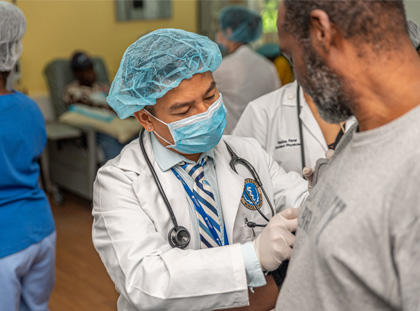For many incoming students, the period between getting accepted into med school and starting your first semester can seem endless. You’ve read plenty about the school you’re planning to attend and its curriculum, but there are still some looming questions: what will your first week at a Caribbean medical school be like? What to expect at a Caribbean medical school as a new student?
It’s a question that fills every student with a mix of excitement and anxiety as they await the day when they can finally set foot on campus. And while you won’t really know what med school is like until you’re in the thick of it, it helps to paint a mental picture of your day-to-day life as you train to enter the medical profession. So let’s look at what a first-year student at RUSM can expect, from their first week at a Caribbean medical school to first-semester coursework.
Typical Week Of A Caribbean Medical Student
When you arrive in Barbados for your first week at RUSM, you’ll first settle into your new home at The Villages of Coverley, a community of three- to four-bedroom houses where all first-semester students live. The Villages are a short shuttle ride from the RUSM campus and provide students with a built-in community. You can attend student events, go to exercise classes at the gym, dine at restaurants and cafes, buy your groceries or go to the medical clinic and pharmacy all within the Villages.
Your first week as a new Caribbean medical student at RUSM will include starting your classes and getting you acclimated to life as a doctor-in-training. On-campus institutions such as the Academy for Teaching and Learning (ATL) offer orientation events so that you can learn about their programming. ATL helps students improve their learning strategies and other aspects of their performance as a physician and offer training and personal support throughout your time at RUSM.
Toward the end of your first week, you’ll attend the white coat ceremony, an event that welcomes incoming medical students and marks the official beginning of your transition to being a doctor-in-training. You’ll hear from keynote speakers about the significance of wearing the white coat and close the ceremony by reciting the Modified Oath of Geneva with your fellow classmates.
Caribbean Medical School: What To Expect After The First Week
You may be wondering what to expect at a Caribbean medical school after your first initial week. Once you’re through the orientation period, you’ll begin coursework in earnest. Your first semester will include foundational classes that follow the Medical Sciences model, which offers a mix of basic science and clinical science courses. Each semester, you’ll learn the physiological, anatomical, and biochemical processes of an organ system all at once, allowing you to see how these different systems work together and understand the processes of health and disease in a holistic fashion.
A key part of RUSM’s teaching philosophy involves integrating active learning experiences so that you can put what you’ve learned into practice. Your first semester will include a mix of classroom work, clinical skills training, standardized patient cases, and small-group learning activities, all of which will prepare you for future clinical rotations.
In RUSM’s state-of-the art Simulation Lab, for example, you’ll be able to safely learn and practice key clinical skills without the anxiety of harming a patient. The simulators—lifelike mannequins that blink, speak, breathe, have a heartbeat and pulse—mirror human responses to such procedures as CPR, intravenous medication, and intubation, allowing you to practice how to make critical decisions about your patient’s care. You’ll also spend time in the Examinations Lab, where standard hospital procedures are carefully recreated so that you’ll learn how to go through a patient’s case, make a diagnosis, and develop and administer a treatment.
“Practice takes the nervousness out of the equation and trains students in how to treat the patient so that when they are faced with real patients, they can manage their nervousness and focus on the task at hand,” says Ricardo Hood, director of medical simulation and Vice Chair of clinical foundations at RUSM.
All first-year students also spend time in the digital anatomy lab, which includes tables with life-size digital cadavers that you can safely dissect and explore. There are also “Living Anatomy” stations, where you can practice palpation, finding pulses, and matching surface anatomy with underlying structures on live subjects.
This blending of first-year coursework with the digital anatomy lab allows you to better understand the relationships between structures and how anatomy will apply to you as a physician. “We don’t just want students to memorize the structures; we want them to understand why they have to know what the structures are and how they relate to each other,” says Nicole Reeves, professor of anatomy at RUSM.
It is normal for new med students to feel anxious about the road that lies ahead of them. Your first week at a Caribbean medical school may seem nerve-racking. But rest assured that at RUSM, you will have the support of faculty, staff, and your colleagues to meet the challenges that lie ahead. And much of the anxiety will dissipate once you’re in the classroom and lab and feel the excitement of putting your learning and skills into practice!
Want to learn more about life as a med student at RUSM? Start here!
Related resources:



